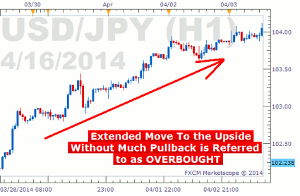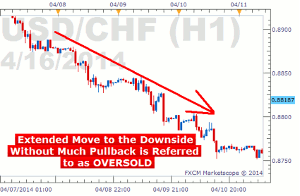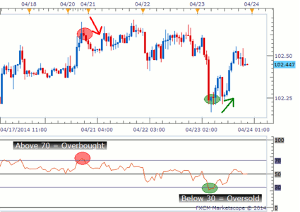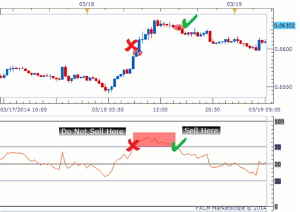Currency pairs that are overbought or oversold usually have a greater chance of reversing direction, so traders will want to identify these moves ahead of time to capitalize on the opportunities they present, says Rob Pasche of DailyFX.com.
Like many professions, trading involves a lot of jargon that is difficult to follow by someone new to the industry. It’s our job as instructors to fill in as many knowledge gaps as possible to make the education process as simple as possible. Today, we will take a look at what it means for a currency pair to be overbought or oversold, and most importantly, what trading opportunities arise from these situations.
Overbought vs. Oversold
These two terms actually describe themselves pretty well. Overbought describes a period of time where there has been a significant and consistent upward move in price over a period of time without much pullback. This is clearly defined by a chart showing price movement from the “lower-left to upper-right” like the chart shown below.
USD/JPY Hourly Chart – Overbought

Created using FXCM’s Marketscope 2.0 charts
Click to Enlarge
The term oversold describes a period of time where there has been a significant and consistent downward move in price over a period of time without much pullback. Basically a move from the “upper-left to the lower-right.”
USD/CHF Hourly Chart – Oversold
Because price cannot move in one direction forever, price will turn around at some point. Currency pairs that are overbought or oversold sometimes have a greater chance of reversing direction, but could remain overbought or oversold for a very long time. So we need to use an oscillator to help us determine when a reversal is actually occurring.
Reading the RSI
There is a quick tool you can use to gauge overbought and oversold levels, the relative strength index. The premise is simple, however. When RSI moves above 70, it is overbought and could lead to a downward move. When RSI moves below 30, it is oversold and could lead to an upward move.
Relative Strength Index, Overbought and Oversold Levels
But, we must be patient before we enter our trades, because sometimes the RSI can stay overbought or oversold for quite awhile. The worst thing we can do is try to pick a top or a bottom of a strong move that continues to move into further overbought or oversold territory. So we must wait until the RSI crosses back under 70 or crosses back above 30.
Relative Strength Index, Overbought and Oversold Levels
The image above shows the RSI clearly breaking above the 70 level resulting in an overbought reading, but we do not want to immediately sell because we do not know how far price could continue to rally. We want to wait until the RSI falls back below 70 and then place our sell trade. This gives us a better entry and a higher probability trade.
When the RSI falls below 30, same rules apply. We want to wait until the RSI crosses back above 30 before we place a buy trade.
By Rob Pasche, Trading Instructor, DailyFX.com
























